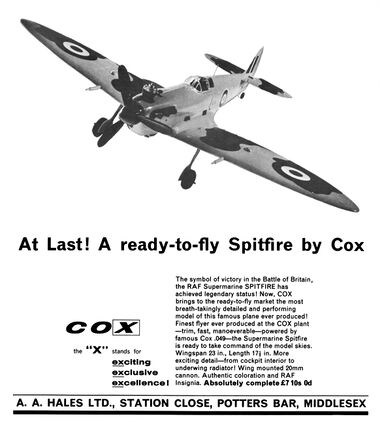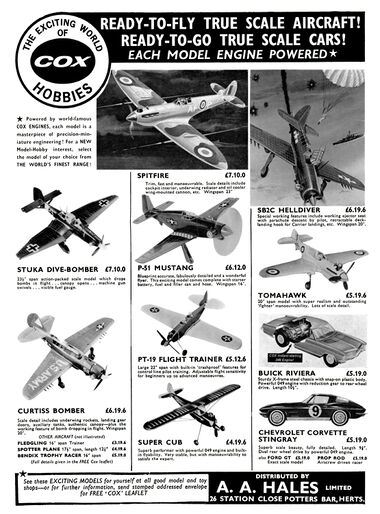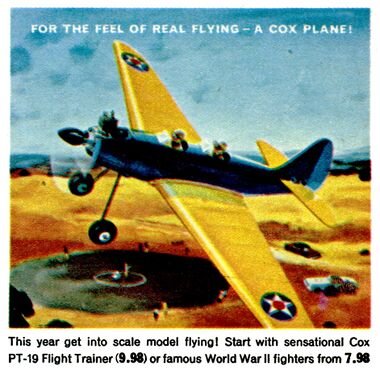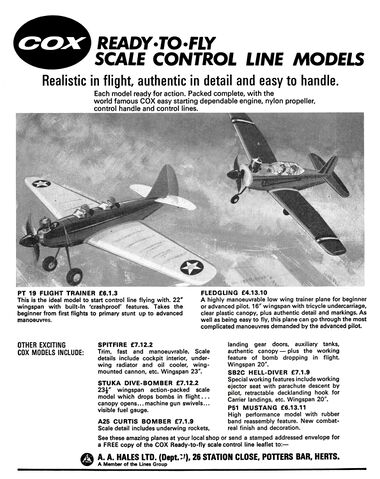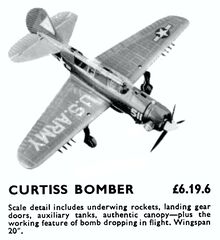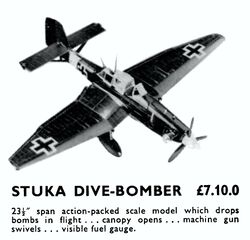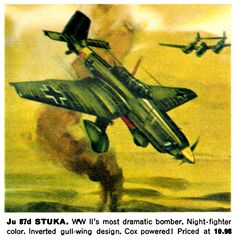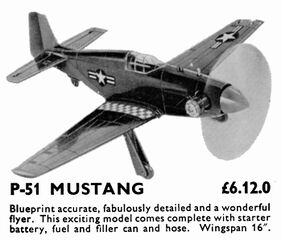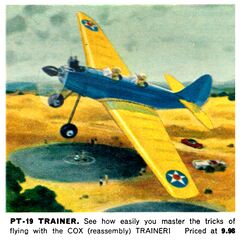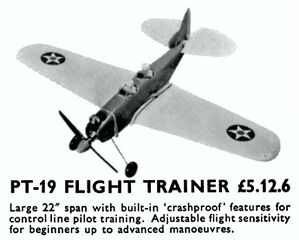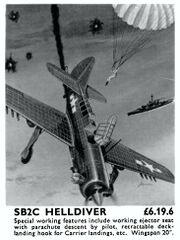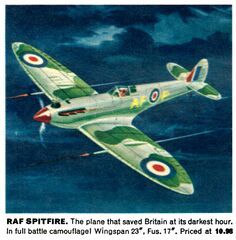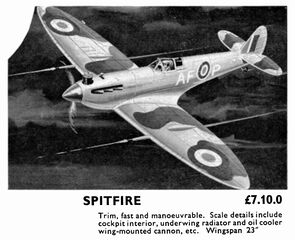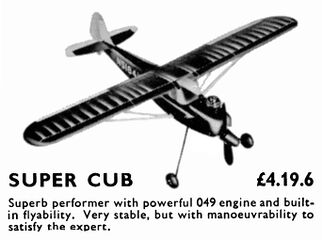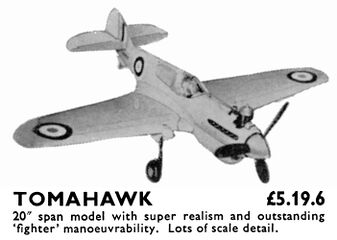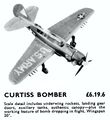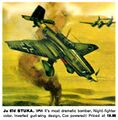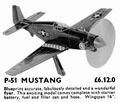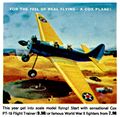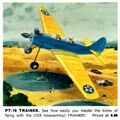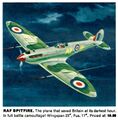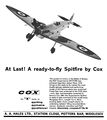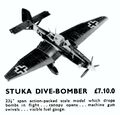Category:Cox control line aircraft
1965: The Cox Ready-to-Fly model Spitfire [image info]
1965: "Exciting World of Cox Hobbies" [image info]
1965: "For the Feel of Real Flying – a Cox Plane!" [image info]
1966: Cox Ready-To-Fly Scale Control Line Models [image info]
After Cox had made a success of selling internal combustion engines for tethered model cars (and the cars themselves), it probably seemed logical to branch out into selling tethered model aircraft.
Control-line model aircraft
Control-line model aircraft may seem like an unfamiliar concept nowadays, now that radio control is commonplace and cheap, but in the early days of mid-sized "engined" model aircraft, where the owner already had to pay out for the model and the engine, the additional cost, weight and bulk of radio control equipment and batteries wasn't so attractive ... and if something went wrong, you were liable to lose your precious model.
A tethered model, controlled via a control line could only really be flown around in circles, but that was enough for the owner to be able to watch their craft flying at a constant distance. Control-line flying also gave a sense of being connected to the craft and feeling its responses, a little like flying a kite. If there was a crosswind, one would have to release some line or step forward when the plane was at one point on the circuit, and pull in some slack or step back when it was at the other side. There was a certain skill and technique to flying safely, and as one graduated to larger and heavier planes, with more detailing that made the aerodynamics more challenging, the skill level needed to avoid crashing the plane became higher. Newcomers were advised to start with a small, stable, simple, "easy" plane until they became proficient, after which they could consider moving up to something more ambitious, that might have extra features like a bomb drop mechanism or an ejecting pilot with parachute.
1966 advertising:
COX Ready-To-Fly Scale Control Line Models
Realistic in flight, authentic in detail and easy to handle.
Each model ready for action. Packed complete, with the world famous COX easy starting dependable engine, nylon propeller, control handle and control lines.
— , Cox, , Meccano Magazine, , December 1966
Some 1966 models:
advertising descriptions
- PT 19 FLIGHT TRAINER £6.1.3
- This is the ideal model to start control line flying with. 22" wingspan with built-in 'crashproof' features. Takes the beginner from first flights to primary stunt up to advanced manoeuvres.
- FLEDGLING £4.13.10
- A highly manoeuvrable low wing trainer plane for beginner or advanced pilot. 16" wingspan with tricycle undercarriage, clear plastic canopy, plus authentic detail and markings. As well as being easy to fly, this plane can go through the most complicated manoeuvres demanded by the advanced pilot.
- SPITFIRE £7.12.2
- Trim, fast and manoeuvrable. Scale details include cockpit interior, under-wing radiator and oil cooler, wing-mounted cannon, etc. Wingspan 23".
- STUKA DIVE-BOMBER £7.12.2
- 23½" wingspan action-packed scale model which drops bombs in flight ... canopy opens ... machine gun swivels ... visible fuel gauge.
- A25 CURTIS BOMBER £7.1.9
- Scale detail includes underwing rockets, landing gear doors, auxiliary tanks, authentic canopy – plus the working feature of bomb dropping in flight. Wingspan 20".
- SB2C HELL-DIVER £7.1.9
- Special working features include working ejector seat with parachute descent by pilot, retractable decklanding hook for Carrier landings, etc. Wingspan 20"
- P51 MUSTANG £6.13.11
- High performance model with rubber band reassembly feature. New combat-real finish and decoration.
Images
External links
- Remember the Cox control-line airplane days? (cs.finescale.com)
- Thimble Drome powered models (www.mh-aerotools.de)
- So what was your first control line plane, and what was the year, and age that you ... (rcuniverse.com)
- Antique Cox Control Line Plane's History and flights by NightFlyyer (youtube.com) – video
Pages in category ‘Cox control line aircraft’
This category contains only the following page.
Media in category ‘Cox control line aircraft’
The following 15 files are in this category, out of 15 total.
- Cox control line models (MM 1966-12).jpg 2,379 × 3,000; 1.18 MB
- Curtiss Bomber, Cox control-line aircraft (MM 1965-12).jpg 1,412 × 1,543; 217 KB
- Exciting World of Cox Hobbies (MM 1965-12).jpg 1,478 × 2,000; 560 KB
- Ju 87D Stuka, Cox model aircraft (BoysLife 1965-11).jpg 1,575 × 1,600; 497 KB
- P-51 Mustang, Cox control-line aircraft (MM 1965-12).jpg 1,393 × 1,189; 212 KB
- PT-19 Flight Trainer, Cox (BoysLife 1965-12).jpg 1,881 × 1,830; 642 KB
- PT-19 Flight Trainer, Cox control-line aircraft (MM 1965-12).jpg 1,377 × 1,105; 176 KB
- PT19 Trainer, Cox (BoysLife 1965-11).jpg 1,600 × 1,597; 482 KB
- RAF Spitfire, 23-inch, Cox (BoysLife 1965-11).jpg 1,571 × 1,600; 436 KB
- SB2C Helldiver, Cox control-line aircraft (MM 1965-12).jpg 1,460 × 1,944; 443 KB
- Spitfire, Cox control-line aircraft (MM 1965-12).jpg 1,917 × 1,561; 503 KB
- Spitfire, Cox, Hales Ltd (TriangMag 1965-01).jpg 2,326 × 2,600; 437 KB
- Stuka Dive-Bomber, Cox control-line aircraft (MM 1965-12).jpg 1,421 × 1,364; 182 KB
- Super Cub, Cox control-line aircraft (MM 1965-12).jpg 1,365 × 1,019; 140 KB
- Tomahawk, Cox control-line aircraft (MM 1965-12).jpg 1,402 × 1,000; 135 KB
